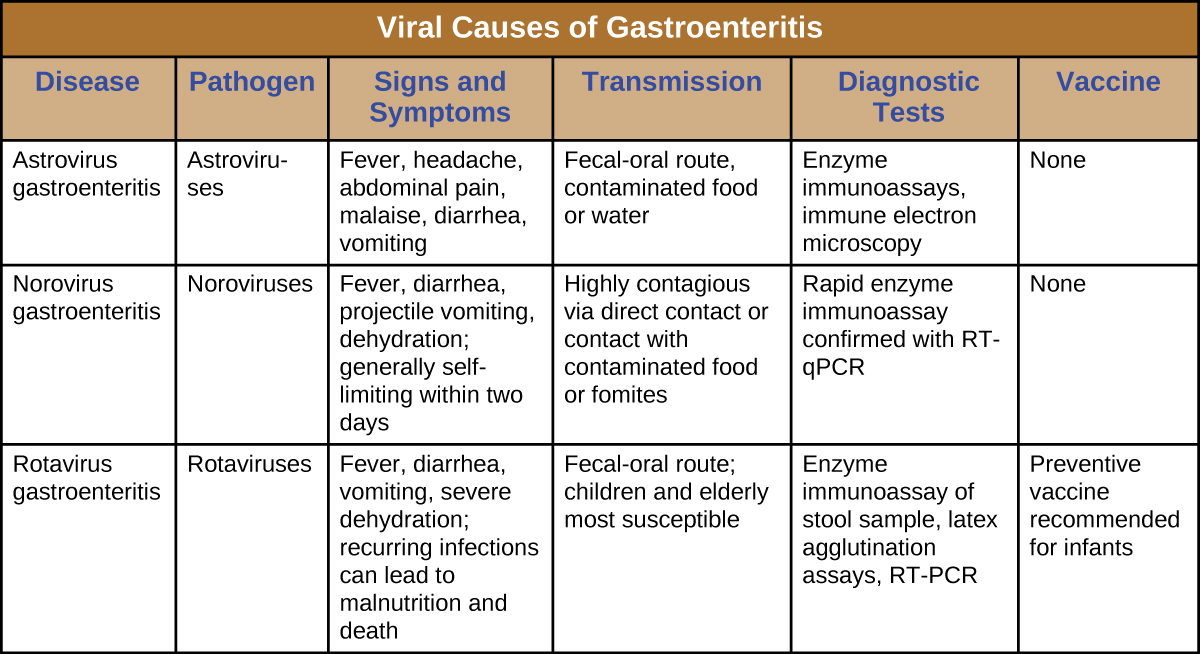| << Chapter < Page | Chapter >> Page > |
The most common clinical tool for diagnosis is enzyme immunoassay, which detects the virus from fecal samples. Latex agglutination assays are also used. Additionally, the virus can be detected using electron microscopy and RT-PCR.
Treatment is supportive with oral rehydration therapy. Preventive vaccination is also available. In the United States, rotavirus vaccines are part of the standard vaccine schedule and administration follows the guidelines of the World Health Organization (WHO). The WHO recommends that all infants worldwide receive the rotavirus vaccine, the first dose between six and 15 weeks of age and the second before 32 weeks. World Health Organization. “Rotavirus.” Immunization, Vaccines, and Biologicals. Updated April 21, 2010. http://www.who.int/immunization/topics/rotavirus/en/.
Noroviruses , commonly identified as Norwalk viruses , are caliciviruses . Several strains can cause gastroenteritis . There are millions of cases a year, predominately in infants, young children, and the elderly. These viruses are easily transmitted and highly contagious. They are known for causing widespread infections in groups of people in confined spaces, such as on cruise ships. The viruses can be transmitted through direct contact, through touching contaminated surfaces, and through contaminated food. Because the virus is not killed by disinfectants used at standard concentrations for killing bacteria, the risk of transmission remains high, even after cleaning.
The signs and symptoms of norovirus infection are similar to those for rotavirus , with watery diarrhea, mild cramps, and fever. Additionally, these viruses sometimes cause projectile vomiting. The illness is usually relatively mild, develops 12 to 48 hours after exposure, and clears within a couple of days without treatment. However, dehydration may occur.
Norovirus can be detected using PCR or enzyme immunoassay (EIA) testing. RT-qPCR is the preferred approach as EIA is insufficiently sensitive. If EIA is used for rapid testing, diagnosis should be confirmed using PCR. No medications are available, but the illness is usually self-limiting. Rehydration therapy and electrolyte replacement may be used. Good hygiene, hand washing, and careful food preparation reduce the risk of infection.
Astroviruses are single-stranded RNA viruses (family Astroviridae ) that can cause severe gastroenteritis, especially in infants and children. Signs and symptoms include diarrhea, nausea, vomiting, fever, abdominal pain, headache, and malaise. The viruses are transmitted through the fecal-oral route (contaminated food or water). For diagnosis, stool samples are analyzed. Testing may involve enzyme immunoassays and immune electron microscopy. Treatment involves supportive rehydration and electrolyte replacement if needed.
A number of viruses can cause gastroenteritis , characterized by inflammation of the GI tract and other signs and symptoms with a range of severities. As with bacterial GI infections, some cases can be relatively mild and self-limiting, while others can become serious and require intensive treatment. Antimicrobial drugs are generally not used to treat viral gastroenteritis; generally, these illnesses can be treated effectively with rehydration therapy to replace fluids lost in bouts of diarrhea and vomiting. Because most viral causes of gastroenteritis are quite contagious, the best preventive measures involve avoiding and/or isolating infected individuals and limiting transmission through good hygiene and sanitation.


Notification Switch
Would you like to follow the 'Microbiology' conversation and receive update notifications?